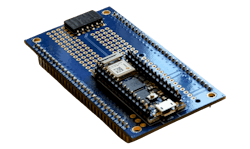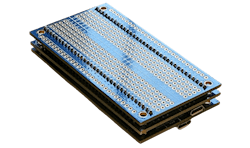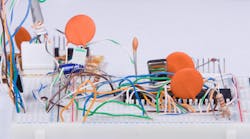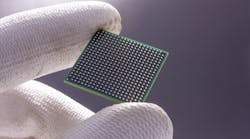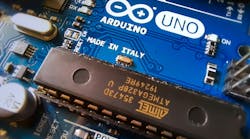“Sandwizz” Schematic-Configurable Breadboard Kickstarter Hits 120% Of Funding Goal
What you’ll learn:
- Microaware’s Sandwizz, a schematic-configurable breadboard, hit 120% of its funding goal on Kickstarter on July 19, 2024.
- The KiCad freeware schematic capture tool is used to configure an active circuit breadboard.
- Library cards with Arduino Nano and protoboard function can be added.
- Sandwizz-breadboard features include integrated op amps, comparators, PGAs, DACs, analog muxes, TTL digital functions, as well as a variable power supply and function generator.
EIM’s Kickstarter campaign, featuring a book on analog and semiconductors, was covered by Electronic Design in an article here. The introductory-level book was accompanied, optionally, by the components needed to implement its example devices and circuits with higher “pledge” levels, including breadboards, power supplies, and rudimentary lab equipment in the Kickstarter campaign that’s active (click here).
The intent of EIM was to provide basic knowledge and education, as well as a medium for review and keeping one’s axe sharp, for a broad range of users that could include engineers and their kids/grandkids/significant others, technicians, students, academia, Makers, Arduino afficionados, and coders who seem to always dream of playing with hardware but get stymied by pullup resistors.
One “feature” of Kickstarter is that they have a promotional section at the bottom of each campaign page that has related Kickstarter projects and those that may be of interest to its signed-in member (they’re watching…). This is how Microaware’s “Sandwizz” campaign, now active, was discovered on Kickstarter.
Here’s the Sandwizz Scoop
Sandwizz might sound like yet another of the many kitty litterboxes that pervade Kickstarter, but it seems like a spiffy breadboard prototyping technology that’s likely to pique Electronic Design readers’ interest. The Sandwizz (Microaware pronounces it “sandwich”) breadboard system incorporates an “SoC” (an Infineon/Cypress PSoC 5) that’s integrated under its breadboard to create what Microaware calls a “Sandwizz-breadboard” (Fig. 1).
Unlike conventional breadboards where components are placed into the breadboard’s socket field, interconnected by jumper wires, Sandwizz integrates components and interconnects within the breadboard itself. It’s a sandwich of a conventional breadboard and a circuit board hosting devices that include the SoC and makes the connections electronically.
This configurable breadboard’s design flow begins in unorthodox fashion by using KiCad, a freeware circuit board design tool that’s available for PC, Mac, and Linux, to capture a schematic comprised of components that can be a mix of user, and Sandwizz-embedded, components. Each Sandwizz-breadboarded CY8C5868AXI-LP032 “SoC” can provide up to four op amps, four comparators, two programmable gain amplifiers, three digital-to-analog converters (DACs), three Vrefs, and three 4-input analog multiplexers on the analog side (Fig. 2).
The Sandwizz also has an integrated programmable gate array that can provide an assortment of digital and “synthesized” functions, which presently includes a pre-synthesized function generator and popular TTL gates in Sandwizz’s KiCad library. The power supply, integrated into the Sandwizz-breadboard, uses either a USB or external +5-V power source and provides user-programmable supply voltages.
After completing schematic capture, the user generates a KiCad netlist that then feeds Microaware’s secret-sauce translator. It configures the Sandwizz-breadboard’s SoC and provides a netlist and location describing where each of the external components plugs into the Sandwizz-breadboard. A good overview of the design process, using a Class B amplifier as an example, is shown in the following video:
Checking Out Arduino for the Breadboard
The basic Sandwizz-breadboard and programmable functions are expandable through the addition of “library cards” in a similar concept to an Arduino shield. Library cards can include an Arduino Nano library card (Fig. 3) or a protoboard library card (Fig. 4), available as additional pieces in a higher pledge-level package. Microaware’s recent video shows the Nano library card being integrated with a Sandwizz.
For larger and more complex projects, the system is expandable to multiple Sandwizz-breadboards using an expansion connector that facilitates nose-to-tail docking. Node voltages in the schematic can also allegedly be soft-probed.
Red Pill or Blue Pill?
Sandwizz doesn’t use more expensive analog crosspoint switches to make breadboard connections. Rather, it relies on the inherent higher-resistivity connectivity provided in the PSoC device, which provides the targeted functionality that differentiates Sandwizz from other intelligent breadboards.
“If in the future we find that there is a demand for a [more expensive] full analog matrix, we could create a library board that can be added underneath. This would enable full matrix switching between all breadboard pins, but it is an option we would consider if the market demands it and users are willing to pay for it.”—Microaware
Speaking of higher-resistivity, Bob Pease did a nice writeup on the general limitations of prototyping with breadboards.
Though Sandwizz will not be open-sourced, Microaware does plan to release schematics after fulfilling its Kickstarter backer pledges around November 2024, retaining full rights to the design after doing so. They believe the schematics will aid users in understanding how Sandwizz signal lines are routed to/from the SoC.
Y0?
Microaware’s “Sandwizz” Kickstarter campaign ended on July 19 and the project’s Kickstarter video is shown below, provided for your convenience. Check out Microaware’s Kickstarter here and feel free to leave comments, below, on what you think of this innovative approach to breadboarding. If not anything else, it seems like a pretty decent PSoC 5 application/eval board.
At the least, Sandwizz forces circuits to be documented up front, a process almost every design engineer can’t wait to do (/sarc). I’d point out that PeaseCAD seemed to work very well for documenting prototypes. However, Bob Pease was exceptional to almost every rule and his uniquely fonted schematics seemed to give Paul Rako heartburn to where he’d redraw Bob’s schematics in ORCAD.
This project made its funding goal, so there should be a Sandwizz-breadboard set coming this way towards the end of 2024 for a tirekicking after their development and testing stabilize.
Kickstarter isn’t a store and it’s risky in terms of losing all pledged money. But at the same time, if innovation wasn’t encouraged and supported, we’d still be using iron sights instead of op amps on anti-aircraft guns.
Microaware’s Kickstarter campaign video for the Sandwizz-breadboard.



